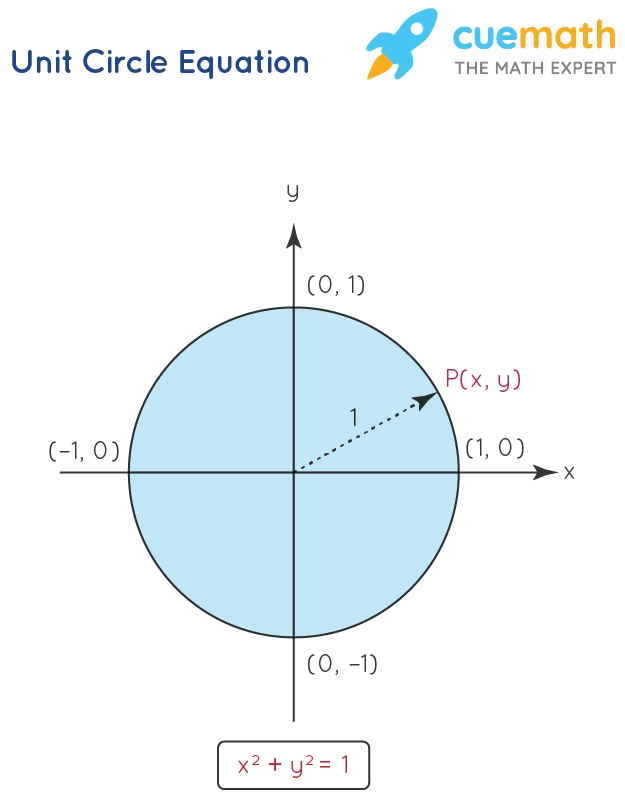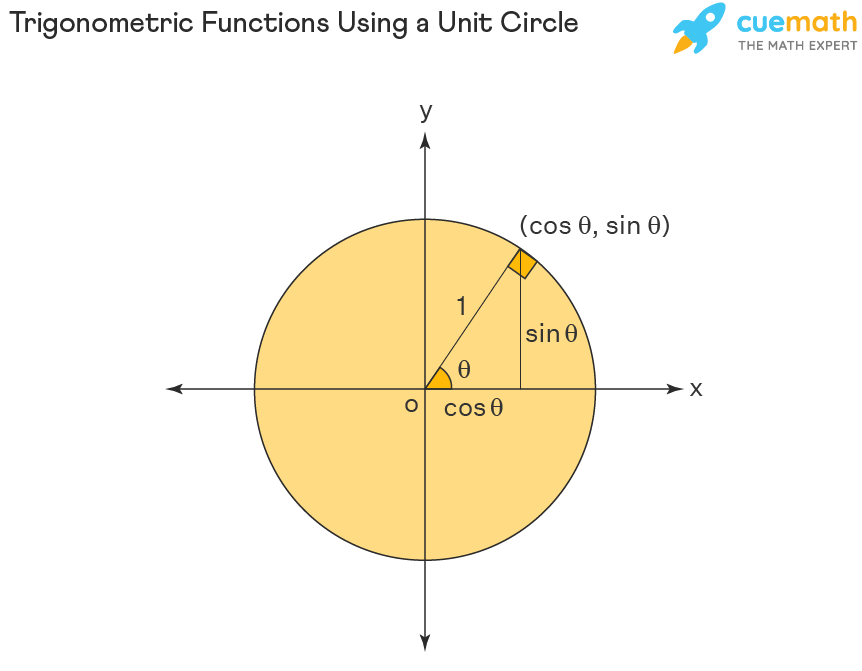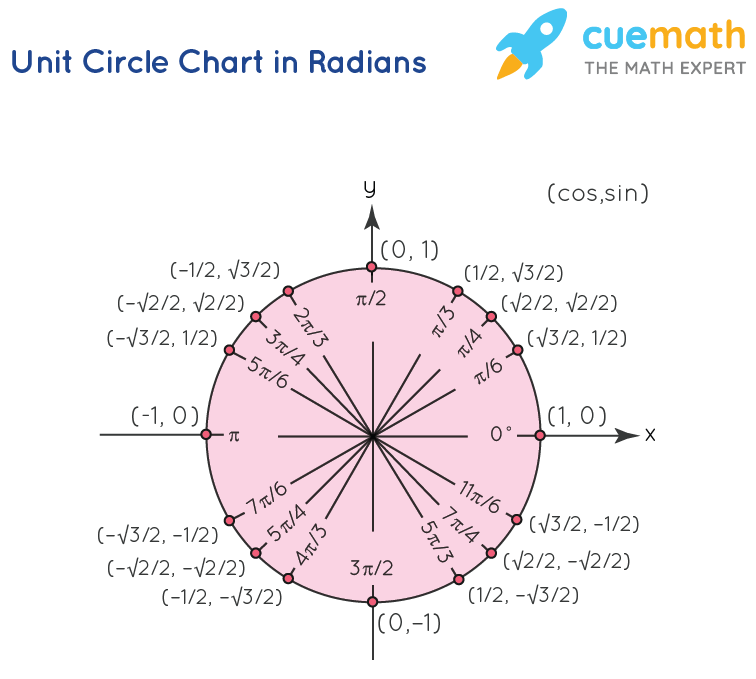Unit Circle
A unit circle from the name itself defines a circle of unit radius. A circle is a closed geometric figure without any sides or angles. The unit circle has all the properties of a circle, and its equation is also derived from the equation of a circle. Further, a unit circle is useful to derive the standard angle values of all the trigonometric ratios.
Here we shall learn the equation of the unit circle, and understand how to represent each of the points on the circumference of the unit circle, with the help of trigonometric ratios of cosθ and sinθ.
What is Unit Circle?
A unit circle is a circle with a radius measuring 1 unit. The unit circle is generally represented in the cartesian coordinate plane. The unit circle is algebraically represented using the second-degree equation with two variables x and y. The unit circle has applications in trigonometry and is helpful to find the values of the trigonometric ratios sine, cosine, tangent.
Unit Circle Definition
The locus of a point which is at a distance of one unit from a fixed point is called a unit circle.
Equation of a Unit Circle
The general equation of a circle is (x - a)2 + (y - b)2 = r2, which represents a circle having the center (a, b) and the radius r. This equation of a circle is simplified to represent the equation of a unit circle. A unit circle is formed with its center at the point(0, 0), which is the origin of the coordinate axes. and a radius of 1 unit. Hence the equation of the unit circle is (x - 0)2 + (y - 0)2 = 12. This is simplified to obtain the equation of a unit circle.
Equation of a Unit Circle: x2 + y2 = 1
Here for the unit circle, the center lies at (0,0) and the radius is 1 unit. The above equation satisfies all the points lying on the circle across the four quadrants.

Finding Trigonometric Functions Using a Unit Circle
We can calculate the trigonometric functions of sine, cosine, and tangent using a unit circle. Let us apply the Pythagoras theorem in a unit circle to understand the trigonometric functions. Consider a right triangle placed in a unit circle in the cartesian coordinate plane. The radius of the circle represents the hypotenuse of the right triangle. The radius vector makes an angle θ with the positive x-axis and the coordinates of the endpoint of the radius vector is (x, y). Here the values of x and y are the lengths of the base and the altitude of the right triangle. Now we have a right angle triangle with the sides 1, x, y. Applying this in trigonometry, we can find the values of the trigonometric ratio, as follows:
- sinθ = Altitude/Hypoteuse = y/1
- cosθ = Base/Hypotenuse = x/1

We now have sinθ = y, cosθ = x, and using this we now have tanθ = y/x. Similarly, we can obtain the values of the other trigonometric ratios using the right-angled triangle within the unit circle. Also by changing the θ values we can obtain the principal values of these trigonometric ratios.
Unit Circle with Sin Cos and Tan
Any point on the unit circle has coordinates(x, y), which are equal to the trigonometric identities of (cosθ, sinθ). For any values of θ made by the radius line with the positive x-axis, the coordinates of the endpoint of the radius represent the cosine and the sine of the θ values. Here we have cosθ = x, and sinθ = y, and these values are helpful to compute the other trigonometric ratio values. Applying this further we have tanθ = sinθ/cosθ or tanθ = y/x.
Another important point to be understood is that the sinθ and cosθ values always lie between 1 and -1, and the radius value is 1, and it has a value of -1 on the negative x-axis. The entire circle represents a complete angle of 360º and the four quadrant lines of the circle make angles of 90º, 180º, 270º, 360º(0º). At 90º and at 270º the cosθ value is equal to 0 and hence the tan values at these angles are undefined.
Example: Find the value of tan 45º using sin and cos values from the unit circle.
Solution:
We know that, tan 45° = sin 45°/cos 45°
Using the unit circle chart:
sin 45° = 1/√2
cos 45° = 1/√2
Therefore, tan 45° = sin 45°/cos 45°
= (1/√2)/(1/√2)
= 1
Answer: Therefore, tan 45° = 1
Unit Circle Chart in Radians
The unit circle represents a complete angle of 2π radians. And the unit circle is divided into four quadrants at angles of π/2, π. 3π/2, and 2π respectively. Further within the first quadrant at the angles of 0, π/6, π/4, π/3, π/2 are the standard values, which are applicable to the trigonometric ratios. The points on the unit circle for these angles represent the standard angle values of the cosine and sine ratios. On close observation of the below figure the values are repeated across the four quadrants, but with a change in sign. This change in sign is because of the reference x-axis and y-axis, which are positive on one side and negative on the other side of the origin. Now with the help of this, we can easily find the trigonometric ratio values of standard angles, across the four quadrants of the unit circle.

Unit Circle and Trigonometric Identities
The unit circle identities of sine, cosecant, and tangent can be further used to obtain the other trigonometric identities such as cotangent, secant, and cosecant. The unit circle identities such as cosecant, secant, cotangent are the respective reciprocal of the sine, cosine, tangent. Further, we can obtain the value of tanθ by dividing sinθ with cosθ, and we can obtain the value of cotθ by dividing cosθ with sinθ.
For a right triangle placed in a unit circle in the cartesian coordinate plane, with hypotenuse, base, and altitude measuring 1, x, y units respectively, the unit circle identities can be given as,
- sinθ = y/1
- cosθ = x/1
- tanθ = sinθ/cosθ = y/x
- sec(θ = 1/x
- csc(θ) = 1/y
- cot(θ) = cosθ/sinθ = x/y
Unit Circle Pythagorean Identities
The three important Pythagorean identities of trigonometric ratios can be easily understood and proved with the unit circle. The Pythagoras theorem states that in a right-angled triangle the square of the hypotenuse is equal to the sum of the square of the other two sides. The three Pythagorean identities in trigonometry are as follows.
- sin2θ + cos2θ = 1
- 1 + tan2θ = sec2θ
- 1 + cot2θ = cosec2θ
Here we shall try to prove the first identity with the help of the Pythagoras theorem. Let us take x and y as the legs of the right-angled triangle having a hypotenuse 1 unit. Applying Pythagoras theorem we have x2 + y2 = 1 which represents the equation of a unit circle. Also in a unit circle, we have, x = cosθ, and y = sinθ, and applying this in the above statement of the Pythagoras theorem, we have, cos2θ + sin2θ = 1. Thus we have successfully proved the first identity using the Pythagoras theorem. Further within the unit circle, we can also prove the other two Pythagorean identities.
Unit Circle and Trigonometric Values
The various trigonometric identities and their principal angle values can be calculated through the use of a unit circle. In the unit circle, we have cosine as the x-coordinate and sine as the y-coordinate. Let us now find their respective values for θ = 0°, and θ = 90º.

For θ = 0°, the x-coordinate is 1 and the y-coordinate is 0. Therefore, we have cos0º = 1, and sin0º = 0. Let us look at another angle of 90º. Here the value of cos90º = 1, and sin90º = 1. Further, let us use this unit circle and find the important trigonometric function values of θ such as 30º, 45º, 60º. Also, we can also measure these θ values in radians. We know that 360° = 2π radians. We can now convert the angular measures to radian measures and express them in terms of the radians.
Unit Circle Table:
The unit circle table is used to list the coordinates of the points on the unit circle that corresond to common angles with the help of trigonometric ratios.
| Angle θ | Radians | Sinθ | Cosθ | Tanθ = Sinθ/Cosθ | Coordinates |
|---|---|---|---|---|---|
| 0° | 0 | 0 | 1 | 0 | (1, 0) |
| 30° | π/6 | 1/2 | √3/2 | 1/√3 | (√3/2, 1/2) |
| 45° | π/4 | 1/√2 | 1/√2 | 1 | (1/√2, 1/√2) |
| 60° | π/3 | √3/2 | 1/2 | √3 | (1/2, √3/2) |
| 90° | π/2 | 1 | 0 | undefined | (0,1) |
We can find the secant, cosecant, and cotangent functions also using these formulas:
- secθ = 1/cosθ
- cosecθ = 1/sinθ
- cotθ = 1/tanθ
We have discussed the unit circle for the first quadrant. Similarly, we can extend and find the radians for all the unit circle quadrants. The numbers 1/2, 1/√2, √3/2, 0, 1 repeat along with the sign in all 4 quadrants.
Unit Circle in Complex Plane
A unit circle consists of all complex numbers of absolute value as 1. Therefore, it has the equation of |z| = 1. Any complex number z = x + \(i\)y will lie on the unit circle with equation given as x2 + y2 = 1.
The unit circle can be considered as unit complex numbers in a complex plane, i.e., the set of complex numbers z given by the form,
z = e\(i\)t = cos t + \(i\) sin t = cis(t)
The relation given above represents Euler's formula.
Unit Circle Examples
-
Example 1: Does the point P (1/2, 1/2) lie on the unit circle?
Solution:
We know that equation of a unit circle is:
x2 + y2 = 1
Substituting x = 1/2 and y = 1/2, we get:
= x2 + y2
= (1/2)2 + (1/2)2
= 1/4 + 1/4
= 1/2≠ 1
Since, x2 + y2 ≠ 1, the point P (1/2, 1/2) does not lie on the unit circle.
Answer: Therefore (1/2, 1/2) doesn't lie on the unit circle.
-
Example 2: Find the exact value of tan 210° using the unit circle.
Solution:
We know that
tan 210° = sin 210°/cos210°
Using the unit circle chart:
sin 210° = -1/2
cos 210° = -√3/2
Therefore,
tan 210° = sin 210°/cos 210°
= (-1/2)/(-√3/2)
= 1/√3
Answer: Therefore, tan 210° = 1/√3
-
Example 3: Find the value of sin 900° using unit circle chart.
Solution:
Since, the unit circle has 0°- 360°, let us represent 900° in terms of 360°.
900° is 2 full rotations of 360° and an additional rotation of 180°.
Hence, 900° will have the same trigonometric ratio as 180°.
Therefore,
sin 900° = sin 180°
From the unit circle chart, we know that:
sin 180° = 0
Answer: sin 900° = 0

FAQs on Unit Circle
What is Unit Circle in Math?
A unit circle is a circle with a radius of one unit. Generally, a unit circle is represented in the coordinate plane with its center at the origin. The equation of the unit circle of radius one unit and having the center at (0, 0) is x2 + y2 = 1. Further, the unit circle has applications in trigonometry and is used to find the principal values of sine and cosine trigonometric ratios.
How Do you Find Sin and Cos Using the Unit Circle?
The unit circle can be used to find the values of sinθ and Cosθ. In a unit circle of radius 1 unit and having the center at (0, 0), let us take a radius inclined to the positive x-axis at an angle θ, and the endpoint of the radius as (x, y). Draw a perpendicular from the end of the radius to the x-axis and it forms a right-angled triangle with the radius as the hypotenuse. The adjacent side of this triangle is the x value, the opposite side of the triangle is the y value and the hypotenuse is of 1 unit. Further using the trigonometric ratio formula we have sinθ = Opp/Hyp = y/1, and cosθ = Adj/Hyp = x/1. Thus we have sinθ = y, and cosθ = x.
What is the Unit Circle Definition of Trig Functions?
The trigonometric function can be calculated for the principal values using the unit circle. For a unit circle having the center at the origin(0, 0), the radius of 1 unit, if the radius is inclined at an angle θ and the endpoint of the radius vector is (x, y), then cosθ = x and sinθ = y. Further, all the other trigonometric ratios can be calculated from these two values. Also, the principal values can be computed by changing the θ value.
How to Find Terminal Point on Unit Circle?
The terminal point on a unit circle can be found with the help of the equation of the unit circle x2 + y2 = 1. If the given point satisfies this equation then it is a point lying on the unit circle. Further, the terminal point on the unit value can be found for the θ value, by finding the values of cosθ and sinθ.
What is the Equation of Unit Circle?
The equation of a unit circle is x2 + y2 = 1. Here it is considered that the unit circle has its center at the origin(0, 0) of the coordinate axes, and has a radius of 1 unit. This equation of unit circle has been derived using the help of the distance formula.
How Do you Derive the Equation of a Unit Circle?
The equation of a unit circle can be calculated using the distance formula of coordinate geometry. For a circle having the center at the origin(0, 0), the radius of 1 unit, any point on the circle can be taken as (x, y). Applying the definition of a circle, and using the distance formula we have (x - 0)2 + (y - 0)2 = 1, which can be simplified as x2 + y2 = 1.
When is Tan Undefined on the Unit Circle?
The unit circle having an equation of x2 + y2 = 1 is helpful to find the trigonometric ratios of sinθ = y and cosθ = x. Using these values we can conveniently find the value of tanθ = sinθ/cosθ = y/x. Tanθ will be undefined for cosθ = 0, i.e., when θ is equal to 90° and 270°.
What is the Connection Between Right Triangles and the Unit Circle?
The right triangles and a unit circle are uniquely connected. Any point on the unit circle can be visualized as a right triangle with radius as the hypotenuse of the right triangle and the coordinates of the point as the other two sides of the right triangle. The equation of a circle x2 + y2 = 1 completely satisfies the Pythagoras theorem related to the right triangle. Also, the right triangle within the unit circle is helpful to derive the trigonometric ratio values.
What is the Unit Circle Used for?
The unit circle is prominently useful in trigonometry. For the trigonometric ratios of sinθ, cosθ, tanθ, their principal angle values of 0º, 30º, 45º, 60º, 90º can be easily calculated using the unit circle. Additionally, the unit circle is useful to represent complex numbers in the argand plane.
What are the Quadrants of the Unit Circle?
The unit circle has four quadrants similar to the quadrants in the coordinate system. The four quadrants are of equal area and they represent one-fourth of the area of the circle. Each of the quadrants subtends an angle of 90º or a right angle at the center of the circle.
How Do you Describe a Unit Circle in Terms of Complex Numbers?
A unit circle consists of all complex numbers of absolute value as 1, thus any complex number z = x + \(i\)y will lie on the unit circle with equation given as x2 + y2 = 1. Therefore, the equation of the unit circle can be given as |z| = 1.
visual curriculum